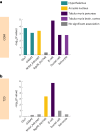Distinct and shared genetic architectures of gestational diabetes mellitus and type 2 diabetes
- PMID: 38182742
- PMCID: PMC10937370
- DOI: 10.1038/s41588-023-01607-4
Distinct and shared genetic architectures of gestational diabetes mellitus and type 2 diabetes
Abstract
Gestational diabetes mellitus (GDM) is a common metabolic disorder affecting more than 16 million pregnancies annually worldwide1,2. GDM is related to an increased lifetime risk of type 2 diabetes (T2D)1-3, with over a third of women developing T2D within 15 years of their GDM diagnosis. The diseases are hypothesized to share a genetic predisposition1-7, but few studies have sought to uncover the genetic underpinnings of GDM. Most studies have evaluated the impact of T2D loci only8-10, and the three prior genome-wide association studies of GDM11-13 have identified only five loci, limiting the power to assess to what extent variants or biological pathways are specific to GDM. We conducted the largest genome-wide association study of GDM to date in 12,332 cases and 131,109 parous female controls in the FinnGen study and identified 13 GDM-associated loci, including nine new loci. Genetic features distinct from T2D were identified both at the locus and genomic scale. Our results suggest that the genetics of GDM risk falls into the following two distinct categories: one part conventional T2D polygenic risk and one part predominantly influencing mechanisms disrupted in pregnancy. Loci with GDM-predominant effects map to genes related to islet cells, central glucose homeostasis, steroidogenesis and placental expression.
© 2024. The Author(s).
Conflict of interest statement
R.K.W. has received honoraria from the Jackson Laboratory and sponsored travel from the Russell Sage Foundation. A.P. is the chief scientific officer for the FinnGen project, which has received funding from 13 pharmaceutical companies. M.J.D. is a founder of Maze Therapeutics. The remaining authors have no competing interests to declare.
Figures



Update of
-
Distinct and shared genetic architectures of Gestational diabetes mellitus and Type 2 Diabetes Mellitus.medRxiv [Preprint]. 2023 Feb 23:2023.02.16.23286014. doi: 10.1101/2023.02.16.23286014. medRxiv. 2023. Update in: Nat Genet. 2024 Mar;56(3):377-382. doi: 10.1038/s41588-023-01607-4. PMID: 36865330 Free PMC article. Updated. Preprint.
References
-
- Williams MA, Qiu C, Dempsey JC, Luthy DA. Familial aggregation of type 2 diabetes and chronic hypertension in women with gestational diabetes mellitus. J. Reprod. Med. 2003;48:955–962. - PubMed
MeSH terms
Grants and funding
LinkOut - more resources
Full Text Sources
Medical

